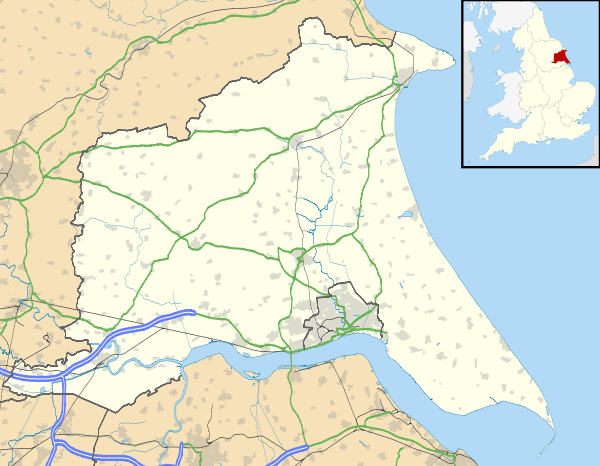Hull Royal Infirmary
Hull Royal Infirmary is a tertiary teaching hospital and is one of the two main hospitals for Kingston upon Hull (the other being Castle Hill Hospital in nearby Cottingham). It is situated on Anlaby Road, just outside the city centre, and is run by Hull University Teaching Hospitals NHS Trust.
| Hull Royal Infirmary | |
|---|---|
| Hull University Teaching Hospitals NHS Trust | |
 Hull Royal Infirmary, Anlaby Road | |

| |
 Shown in East Riding of Yorkshire | |
| Geography | |
| Location | Kingston upon Hull, East Riding of Yorkshire, England |
| Coordinates | 53.744500°N 0.356500°W |
| Organisation | |
| Care system | NHS England |
| Type | Teaching |
| Affiliated university | Hull York Medical School University of Hull |
| Services | |
| Emergency department | Yes, Major Trauma Centre |
| Beds | 700 |
| History | |
| Opened | 1782 |
| Links | |
| Website | https://www.hey.nhs.uk |
| Lists | Hospitals in England |
History
.jpg)
The infirmary was first established in temporary premises in George Street in 1782[1] before permanent premises could be completed and opened in Prospect Street in 1784.[1] John Alderson, a physician at the infirmary, founded the "Sculcoates Refuge for the Insane" in 1814.[2] After the Duke and Duchess of Edinburgh laid the foundation stone for a new building in 1884, it was renamed Hull Royal Infirmary.[3]
After the old buildings in Prospect Street became dilapidated in the 1950s, the infirmary moved to new premises in Anlaby Road, which were designed by architects Yorke Rosenberg Mardall and for which the foundation stone was laid by Enoch Powell on 25 September 1963.[4] The construction was undertaken by Trollope & Colls[5] and the new facilities were opened by the Queen in June 1967.[6] The new hospital incorporated a distinctive 13-storey tower designed to accommodate the majority of the medical facilities.[7]
The hospital's Accident and Emergency Department had a £7 million refurbishment, intended to improve the range the services being offered, in October 2011.[8] Work began to install a new 24-bed prefabricated ward on top of a 4-storey building to the rear of the main tower block in November 2014.[9]
Facilities
The hospital has a dedicated Centre for Magnetic Resonance Investigations on site which houses two MRI scanners.[10] It also houses the dedicated Hull Royal Eye Hospital which provides tertiary level sub-speciality ophthalmic care.[11]
See also
References
| Wikimedia Commons has media related to Hull Royal Infirmary. |
- "Hull 1700". Old Hull. Retrieved 21 April 2018.
- Historic England. "Statue of Dr John Alderson outside Hull Royal Infirmary (1279574)". National Heritage List for England. Retrieved 21 April 2018.
- "Royal Visit to Hull Infirmary of the Duke and Duchess of Edinburgh". Illustrated London News. 1884. Retrieved 21 April 2018.
- "Hull Royal Infirmary celebrates 50th birthday in City of Culture year". ITV. 16 June 2017. Retrieved 21 April 2018.
- "Hull Royal Infirmary" (PDF). Royal Engineers Journal. 1 June 1965. p. i. Retrieved 27 July 2019.
- "The Anlaby Road". p. 16. Retrieved 21 April 2018.
- "Restoring Hull's iconic tower block". Premier Construction News. 31 December 2013. Retrieved 21 April 2018.
- "Hull Royal Infirmary A&E gets £7m revamp". BBC News. BBC. 10 October 2011. Retrieved 1 February 2013.
- "New Hull Royal Infirmary ward to be craned into place". BBC News. BBC. 23 November 2014. Retrieved 5 January 2015.
- "The MRI Department". Hull and East Yorkshire Hospitals NHS Trust. Retrieved 21 April 2018.
- "Hull Royal Infirmary". Sight line directory. Retrieved 22 March 2019.